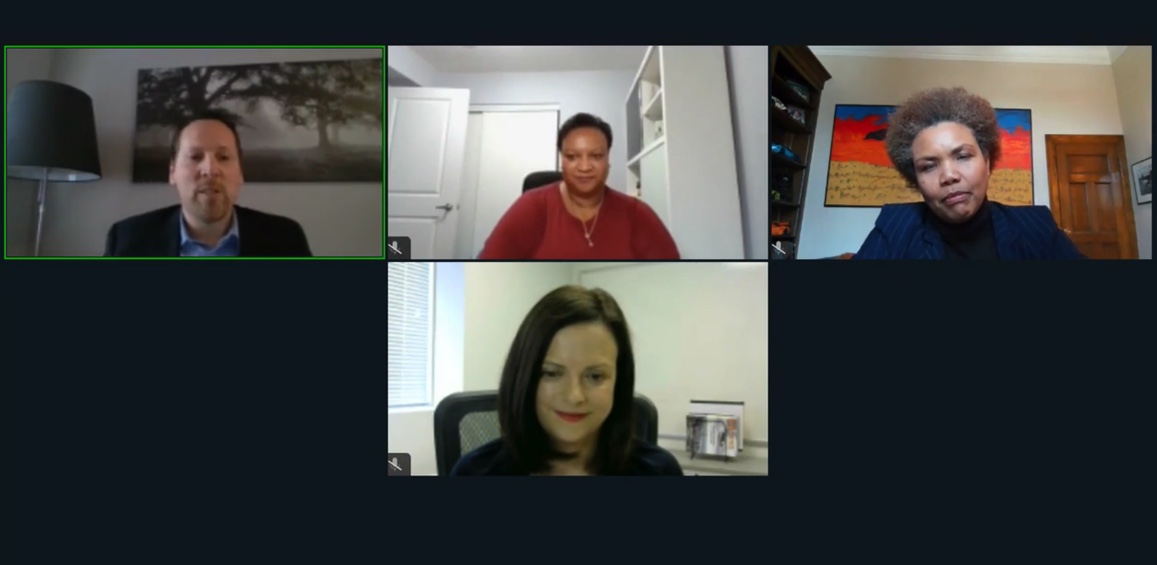
Field Notes: CUTRIC manufacturing panel investigates new technologies in the world of ZEBs
by Sadi Muktadir

CUTRIC panel dives into new technologies by manufacturers to make the clean energy transition easier and more efficient.

Top left: Jonathan Leskewich. Top Right: Mylene Tassy. Bottom: Jennifer McNeill
CUTRIC’s second annual virtual panel took place over two days on March 30th and 31st and a number of sessions were investigating the ongoing clean energy transition in transportation across Canada.
Public transit agencies are at the forefront of transitioning their fleets to cleaner technologies, and many manufacturers are offering a number of new products to make that transition easier.
On March 30th, three manufacturers took part in a panel to describe some of the new cleantech-enabled innovations coming to the Canadian market.
Three manufacturers joined the panel. Jennifer McNeill, VP of Sales and Marketing from New Flyer, Mylene Tassy, VP of Sales and Marketing from Nova Bus and Jonathan Leskewich, Senior Director, Engineering and Product Development at Vicinity Motor Corp.
Jennifer McNeill presented on some of the new technologies NFI Group was bringing to battery electric bus technology.
“We have a new modular battery packaging which we call a ‘juice box’ which has 90% fewer parts than the previous battery packaging. Our second technology is an upgraded traction and propulsion system (Siemens Alpha 3 technology), for smoother acceleration and deceleration at slower speeds, and 90% energy recuperation through braking, helping with range. We also have new, high-energy batteries, which have improved by 13% in terms of energy capacity.”
NFI also mentioned that they have launched six new battery and fuel-cell buses in North American transit agencies.
Currently, Jennifer mentioned that NFI is working on improved vehicle data sharing to triage problems and subsequent actions, perform predictive maintenance and trend analytics and more universal diagnostic solutions across all vehicles.
“If I can leave you with one thought, it’s to always consider the areas of overlap, between bus and charger, charger and utility, and bus and utility,” said Jennifer, referring to how interconnected the manufacturing process for an EV was.
Mylene Tassy presented next, on behalf of Nova Bus.
“For an electrification fleet to succeed, it’s not enough to just fund bus development and manufacturing. It’s a connected ecosystem that needs to provide more than a bus to alleviate our customers other needs as well. So that involved route planning, a new depot, service support, smart charging solutions and things like that,” Mylene said.
Mylene’s presentation focused on Nova Bus’ current offerings, and she mentioned key distinctions on their LFSe+ bus. Namely, a traction motor from BAE systems, a light-weight design, and fewer components and connections to make for a less complex EV.
Next to present was Jonathan Leskewich from Vicinity Motor Corp. Jonathan mentioned four key areas of focus in terms of innovation as a manufacturer. Fleet solutions that have been designed to be electric, new components with a cost-effective performance, less charging infrastructure to lower EV entry costs and what the path forward with Vicinity looks like.
Vicinity mentioned the three vehicles they had focused on shuttle and light transit capabilities, and mentioned a number of seating configurations available on their buses.
Their flagship vehicle has a full air ride suspension for passengers, dedicated driver AC which doubles to reduce heat-load on the bus. The batteries are mounted on the floor, a marked difference from Nova’s buses which place the batteries on the roof.
“Our new technologies are the EXRO coil driver technology, which gives us 295Kw in terms of peak power. These powertrains create two torque curves that give us larger power and a more efficient range. We also have new Proterra batteries for extended range,” Jonathan said.
Jonathan also mentioned that their new coil driver technology eliminates the need for a charger on-board or a dedicated charging station. All it needs is to plug in to a facility’s power grid. This will reportedly reduce the costs needed to electrify a fleet due to less infrastructure needed.
Another new technology they’re working on is a new manufacturing facility in Ferndale, Washington, available for touring by Canadian transit agencies as well.
All three manufacturers closed the panel by fielding questions about supply chain issues, mentioning global challenges around immediate-term customer expectations and expressing hope that these issues will be resolved in the near-term.
The three representatives also mentioned that they are expanding their focus beyond just buses and a 2-3 year vision, and beginning to envision new technologies and innovations that can help create robust infrastructure for a clean economy many years down the line.